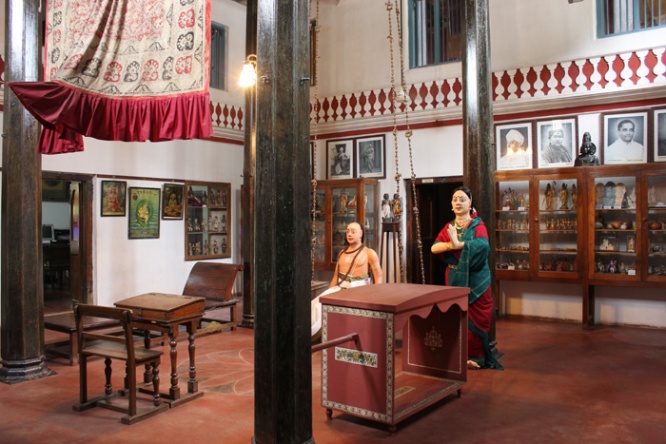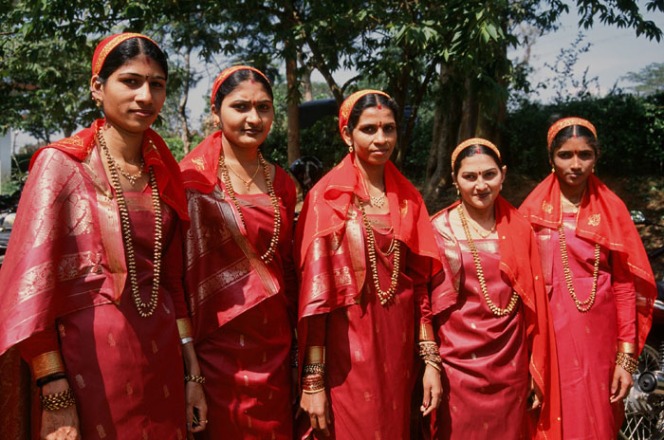ANURAG MALLICK and PRIYA GANAPATHY visit temple towns and weaving villages to uncover the magic of the nine yard sari
In her 100-year-old stone home with polished red oxide floors, paati, our friend’s nonagenarian grandma used to wash all her saris on a granite slab. No army of servants or washing machine for her. A strict practitioner of her Iyengar traditions, she insisted on adhering to the old way – alternating beating her saris with a stick, turning each deftly and rinsing them with enviable strength. Then using a 10ft bamboo stick, she’d singlehandedly balance each of the 9-yards of cloth and cleverly spread it out on high rod near the ceiling to dry!
If anyone touched her sari, she’d scowl, chastise them tersely and repeat the washing process all over again! Sadly, both paati and her heritage home no longer exist but the image of her walking around draped in a madisar, the nine-yard wonder was refreshed when we visited old weaving towns in Tamil Nadu and witnessed traditional weddings.

Varying in length, weave, style, fabric and drape, different cultures have interpreted this ‘unstitched length of cloth’ for over 5000 years. As a symbol of elegance and grace, the simple sari has been adopted as traditional attire for women not only across the Indian subcontinent, but several neighbouring Asian countries as well.
Historical records in Northern India dating as far back as 200 BC, relics from the Indus Valley excavations (2800-1800 BC), epics like the Mahabharata, the Tamil classic Silappadhikaram or Banabhatta’s Sanskrit work Kadambari, ancient cave paintings and sculptures serve as ample proof of how textiles and the sari in particular, evolved into a statement of identity across India.

The sari is still considered to be the most sacred apparel at the time of worship, marriage, religious ceremonies and festivals since it is woven and not tailored. In the early days, needles made of bone were used in stitching, hence men wore dhotis and women wore saris that covered the whole body.
In the Natya Shastra, a treatise on ancient dance and costumes, the navel of the Supreme Being is considered to be the source of life and creativity, hence the midriff was exposed by the sari. Later, this was considered indecent and the drape was accordingly altered. Some believe that the blouse or bustier covering the torso was a 10th Century innovation to meet the demands of a more modest or orthodox society.
Wrapped in a multitude of ways, saris have clung and flattered the voluptuous curves of Indian beauty, stirring passions and rousing poets and artists to write, sculpt and paint. Masterpieces like Raja Ravi Verma’s art, Gandharva sculptures and tomes of literature are testimony to this. Researchers believe that the sari is a combination of ancient everyday attire – a dhoti or sarong and a veil or wrap for the upper body.
The two-piece mundum nerayath or Kerala’s kasavu sari is said to be a remnant of this tradition. Today the Indian sari worn with pleats in the front, the pallu wrapped under the right armpit and thrown elegantly over the left shoulder, typifies formal chic and is the rage on fashion ramps and red carpet events. Embellished with rich embroidery, zardosi or gold zari and well-cut blouses, the sari has defined movie stars and fashionistas, inspired international and Indian designers like Zandra Rhodes and Shaina NC to create revolutionary styles and drapes.

Unique styles have emerged from various regions in terms of weaving style and variety of fabrics. North India is famous for Banarasi, Tanchoi, Chikan, Jamdani while Kanjeevaram and Mysore silks rule the South. In the east, Baluchari, Kantha and Dhaka are most popular and Bandhani, Lehariyas and Chanderi are synonymous with western India.
Be it the kosa weavers of Janjgir Champa in Chhattisgarh or the muga silk weavers of Sualkuchi in Assam, Tamil Nadu’s temple towns of Kumbakonam, Darasuram and Madurai, Ilkal in Karnataka, Dharmavaram in Andhra, Sambalpur in Orissa or Paithan in Maharashtra, India’s corners still resound with the clatter of looms.
The normal 5.6 yard sari worn over a petticoat and a blouse (or choli) can be draped diversely based on which region, community or tribe one belongs to. In North India and Gujarat, women wear the nivi style sari with pleats in the front and a long pallu drawn over the right shoulder with one end pulled across the abdomen and tucked at the back.
The unique Coorg or Kodagu style tucks the pleats behind, wraps the pallu across the bodice and clasps it with a brooch or knot over the right shoulder. Legend has it that the pleats were pushed to the back by the force of the River Cauvery flowing through the land.
The 9-yard sari drape is a tad more complicated that was typically worn by traditional Brahmin women especially in Tamil Nadu, Karnataka, Andhra Pradesh, Maharashtra and Goa. Called madisar in Tamil Nadu or kaccha in Maharashtra and Karnataka, and kaccha nivi in Andhra, the dhoti-style of the 9-yard drape is astonishingly versatile considering it can be worn without a blouse or any underclothes.
It involves a series of pleats, tucks and wraps that ensures you are covered from neck to toe. With one of the folds passed between the legs and tucked into the back (over an optional belt or string) and reams of cloth wrapped around, the style simultaneously covered and protected one’s modesty. Besides, the convenient trouser or dhoti-like style of the kaccha or madisar made it comfortable to work, walk or ride.
For centuries the 9-yard sari has been worn by commoners, fisher folk to queens. Historically brave women like Queen Laxmibai of Jhansi, Rani Chennamma of Kittur or Ahalyabai Holkar of Malwa did not let their gender or costume deter them from going to war. In fact, they flaunted their culture proudly while fighting their enemies. Often statues and pictures depict them as sword-wielding women warriors donned in nine-yard saris astride horses.
Madisars are available in a variety of materials like silk, cotton, cotton-silk blends and polyester-cotton blends. They are a very important part of the Tamil Iyer and Iyengar culture and are included in every bride’s trousseau. The drape varies in the pallu or display end of the sari. It is worn over the right shoulder among Iyers while Iyengars, choose to drape it over the left shoulder.

Madisars are worn on all the major events of a woman’s life right from kalyanam (marriage) to seemantham (equivalent of a baby shower), pujas and death ceremonies. From the coasts of the Konkan to the streets of Kalpathy or the bylanes of old Mysore one can witness how the madisar drape has survived time.
Authors: Anurag Mallick & Priya Ganapathy. This article appeared on 2 July 2012 in Conde Nast Traveller online.




